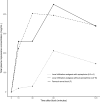Systemic Ropivacaine Concentrations Following Local Infiltration Analgesia and Femoral Nerve Block in Older Patients Undergoing Total Knee Arthroplasty
- PMID: 37731601
- PMCID: PMC10508276
- DOI: 10.2147/LRA.S425353
Systemic Ropivacaine Concentrations Following Local Infiltration Analgesia and Femoral Nerve Block in Older Patients Undergoing Total Knee Arthroplasty
Abstract
Purpose: The study examined the pharmacokinetic profile of fixed formulation mixtures comprising 225 mg of ropivacaine for local infiltration analgesia with or without epinephrine, and femoral nerve block in older patients presenting for orthopedic surgery and explored potential influences of block type, age, and body weight on this profile.
Patients and methods: Twenty four patients scheduled for total knee arthroplasty were randomly assigned to three groups: femoral nerve block, local infiltration analgesia with epinephrine and local infiltration analgesia without epinephrine. Blood samples were collected at 10, 30, 60, and 120 min following the block and total plasma concentrations of ropivacaine were quantified by high performance liquid chromatography.
Results: The mean individual peak total plasma concentrations of ropivacaine in local infiltration analgesia with and without epinephrine, and femoral nerve block group were 0.334, 0.490 and 0.545 μg mL-1 (p = 0.16). Local infiltration with epinephrine group had significantly lower plasma ropivacaine concentrations at 30, 60 and 120 minutes. The plasma ropivacaine concentrations exceeded 2.2 μg mL-1 in one patient. Age, but not body weight, had a moderate correlation with peak plasma ropivacaine concentration (r = 0.37, p = 0.08).
Conclusion: Administration of a fixed 225 mg dose of ropivacaine for local infiltration analgesia with epinephrine and femoral nerve block results in plasma ropivacaine concentrations below the toxicity threshold, indicating their safety. The use of local infiltration analgesia with epinephrine provides a greater safety margin, as local infiltration analgesia without epinephrine may lead to ropivacaine concentrations associated with symptoms of local anesthetic toxicity.
Keywords: anesthetic techniques; anesthetics local; arthroplasty; local anesthetics; regional; ropivacaine; toxicity.
© 2023 Kazune et al.
Conflict of interest statement
The authors report no conflicts of interest in this work.
Figures


Similar articles
-
A randomized study comparing plasma concentration of ropivacaine after local infiltration analgesia and femoral block in primary total knee arthroplasty.Scand J Pain. 2012 Jan 1;3(1):46-51. doi: 10.1016/j.sjpain.2011.09.001. Scand J Pain. 2012. PMID: 29913764
-
Plasma Ropivacaine Concentrations Following Local Infiltration Analgesia in Total Knee Arthroplasty: A Pharmacokinetic Study to Determine Safety Following Fixed-Dose Administration.Reg Anesth Pain Med. 2018 May;43(4):347-351. doi: 10.1097/AAP.0000000000000727. Reg Anesth Pain Med. 2018. PMID: 29369957
-
Local infiltration analgesia in knee and hip arthroplasty efficacy and safety.Scand J Pain. 2016 Oct;13:59-66. doi: 10.1016/j.sjpain.2016.05.041. Epub 2016 Jul 27. Scand J Pain. 2016. PMID: 28850535 Clinical Trial.
-
A comparison of the pharmacodynamics and pharmacokinetics of bupivacaine, ropivacaine (with epinephrine) and their equal volume mixtures with lidocaine used for femoral and sciatic nerve blocks: a double-blind randomized study.Anesth Analg. 2009 Feb;108(2):641-9. doi: 10.1213/ane.0b013e31819237f8. Anesth Analg. 2009. PMID: 19151302 Clinical Trial.
-
High volume local infiltration analgesia compared to peripheral nerve block for hip and knee arthroplasty-what is the evidence?Anaesth Intensive Care. 2013 Jul;41(4):458-62. doi: 10.1177/0310057X1304100404. Anaesth Intensive Care. 2013. PMID: 23808503 Review.
Cited by
-
The preventive efficacy of lipid emulsion on the occurrence of local anesthetic systemic toxicity in patients receiving local infiltration analgesia for total joint arthroplasty.J Orthop Surg Res. 2024 Oct 28;19(1):697. doi: 10.1186/s13018-024-05189-7. J Orthop Surg Res. 2024. PMID: 39468594 Free PMC article.
-
LC-MS/MS assisted pharmacokinetic and tissue distribution study of ropivacaine and 3-OH-ropivacaine on rats after plane block anesthesia.Front Pharmacol. 2025 Jan 7;15:1494646. doi: 10.3389/fphar.2024.1494646. eCollection 2024. Front Pharmacol. 2025. PMID: 39840090 Free PMC article.
-
Incidence of local anesthetic systemic toxicity in patients receiving bupivacaine infiltration analgesia for total joint arthroplasty under general anesthesia: a retrospective single-center study.BMC Anesthesiol. 2024 Nov 21;24(1):422. doi: 10.1186/s12871-024-02816-y. BMC Anesthesiol. 2024. PMID: 39573988 Free PMC article.
-
Effect of adductor canal block combined with infiltration between the popliteal artery and posterior capsular of the knee on chronic pain after total knee arthroplasty: a prospective, randomized, double-blind, placebo-controlled trial.BMC Anesthesiol. 2024 Sep 10;24(1):320. doi: 10.1186/s12871-024-02707-2. BMC Anesthesiol. 2024. PMID: 39256652 Free PMC article. Clinical Trial.
References
LinkOut - more resources
Full Text Sources

